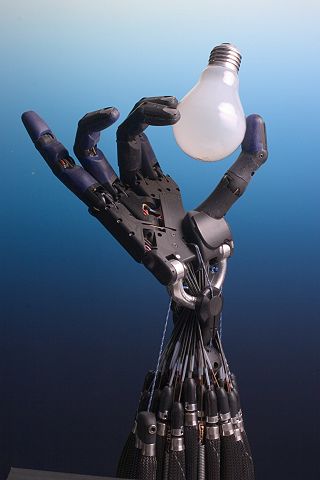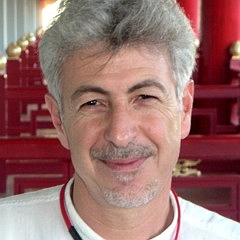Related Research Articles

Computer vision tasks include methods for acquiring, processing, analyzing and understanding digital images, and extraction of high-dimensional data from the real world in order to produce numerical or symbolic information, e.g. in the forms of decisions. Understanding in this context means the transformation of visual images into descriptions of the world that make sense to thought processes and can elicit appropriate action. This image understanding can be seen as the disentangling of symbolic information from image data using models constructed with the aid of geometry, physics, statistics, and learning theory.

Scientific visualization is an interdisciplinary branch of science concerned with the visualization of scientific phenomena. It is also considered a subset of computer graphics, a branch of computer science. The purpose of scientific visualization is to graphically illustrate scientific data to enable scientists to understand, illustrate, and glean insight from their data. Research into how people read and misread various types of visualizations is helping to determine what types and features of visualizations are most understandable and effective in conveying information.
James F. Blinn is an American computer scientist who first became widely known for his work as a computer graphics expert at NASA's Jet Propulsion Laboratory (JPL), particularly his work on the pre-encounter animations for the Voyager project, his work on the 1980 Carl Sagan documentary series Cosmos, and the research of the Blinn–Phong shading model.

Loren C. Carpenter is a computer graphics researcher and developer.

Zillow Group, Inc., or simply Zillow, is an American tech real-estate marketplace company that was founded in 2006 by Rich Barton, Zillow's current CEO, and Lloyd Frink, former Microsoft executives and founders of Microsoft spin-off Expedia; Spencer Rascoff, a co-founder of Hotwire.com; David Beitel, Zillow's current chief technology officer; and Kristin Acker, Zillow's current technology leadership advisor.

Frank Dellaert is a professor in the School of Interactive Computing at the Georgia Institute of Technology. He is also affiliated with the IRIM@GT center and is well known for contributions to Robotics and Computer Vision.
Object recognition – technology in the field of computer vision for finding and identifying objects in an image or video sequence. Humans recognize a multitude of objects in images with little effort, despite the fact that the image of the objects may vary somewhat in different view points, in many different sizes and scales or even when they are translated or rotated. Objects can even be recognized when they are partially obstructed from view. This task is still a challenge for computer vision systems. Many approaches to the task have been implemented over multiple decades.

Robotics is an interdisciplinary branch of electronics and communication, computer science and engineering. Robotics involves the design, construction, operation, and use of robots. The goal of robotics is to design machines that can help and assist humans. Robotics integrates fields of mechanical engineering, electrical engineering, information engineering, mechatronics engineering, electronics, biomedical engineering, computer engineering, control systems engineering, software engineering, mathematics, etc.

Heung-Yeung "Harry" Shum is a Chinese computer scientist. He was a doctoral student of Raj Reddy. He was the Executive Vice President of Artificial Intelligence & Research at Microsoft. He is known for his research on computer vision and computer graphics, and for the development of the search engine Bing.
Amazon Robotics, formerly Kiva Systems, is a Massachusetts-based company that manufactures mobile robotic fulfillment systems. It is a subsidiary company of Amazon.com. Its automated storage and retrieval systems were previously used by companies including The Gap, Walgreens, Staples, Gilt Groupe, Office Depot, Crate & Barrel, and Saks 5th Avenue. After those contracts ran out, Amazon did not renew them and Kiva's assets now work only for Amazon's warehouses.

Yann André LeCun is a Turing Award winning French computer scientist working primarily in the fields of machine learning, computer vision, mobile robotics and computational neuroscience. He is the Silver Professor of the Courant Institute of Mathematical Sciences at New York University and Vice-President, Chief AI Scientist at Meta.
John Matthew Hollerbach is a professor of computer science and research professor of mechanical engineering at the University of Utah. He is the editor of The International Journal of Robotics Research, a Senior Editor of Presence: Teleoperators & Virtual Environments, and a Governing Board member of the electronic journal Haptics-e.
Google Brain was a deep learning artificial intelligence research team under the umbrella of Google AI, a research division at Google dedicated to artificial intelligence. Formed in 2011, Google Brain combined open-ended machine learning research with information systems and large-scale computing resources. The team has created tools such as TensorFlow, which allow for neural networks to be used by the public, with multiple internal AI research projects. The team aims to create research opportunities in machine learning and natural language processing. The team was merged into former Google sister company DeepMind to form Google DeepMind in April 2023.

Oussama Khatib is a roboticist and a professor of computer science at Stanford University, and a Fellow of the IEEE. He is credited with seminal work in areas ranging from robot motion planning and control, human-friendly robot design, to haptic interaction and human motion synthesis. His work's emphasis has been to develop theories, algorithms, and technologies, that control robot systems by using models of their physical dynamics. These dynamic models are used to derive optimal controllers for complex robots that interact with the environment in real-time.

Demetri Terzopoulos is a Greek-Canadian-American computer scientist and entrepreneur. He is currently a Distinguished Professor and Chancellor's Professor of Computer Science in the Henry Samueli School of Engineering and Applied Science at the University of California, Los Angeles, where he directs the UCLA Computer Graphics & Vision Laboratory.
Visual computing is a generic term for all computer science disciplines dealing with images and 3D models, such as computer graphics, image processing, visualization, computer vision, virtual and augmented reality and video processing. Visual computing also includes aspects of pattern recognition, human computer interaction, machine learning and digital libraries. The core challenges are the acquisition, processing, analysis and rendering of visual information. Application areas include industrial quality control, medical image processing and visualization, surveying, robotics, multimedia systems, virtual heritage, special effects in movies and television, and computer games.

The Kahlert School of Computing is a school within the College of Engineering at the University of Utah in Salt Lake City, Utah.
Gordon L. Kindlmann is an American computer scientist who works on information visualization and image analysis. He is recognized for his contributions in developing tools for tensor data visualization.

Hanspeter Pfister is a Swiss computer scientist. He is the An Wang Professor of Computer Science at the Harvard John A. Paulson School of Engineering and Applied Sciences and an affiliate faculty member of the Center for Brain Science at Harvard University. His research in visual computing lies at the intersection of scientific visualization, information visualization, computer graphics, and computer vision and spans a wide range of topics, including biomedical image analysis and visualization, image and video analysis, and visual analytics in data science.

Alois Christian Knoll is German computer scientist and professor at the TUM School of Computation, Information and Technology at the Technical University of Munich (TUM). He is head of the Chair of Robotics, Artificial Intelligence and Embedded Systems.
References
- 1 2 3 "Sing Bing Kang". IEEE Xplore. IEEE. Retrieved 2023-09-25.
- ↑ "Sing Bing Kang". CMU Robotics Institute. Retrieved 2023-09-25.